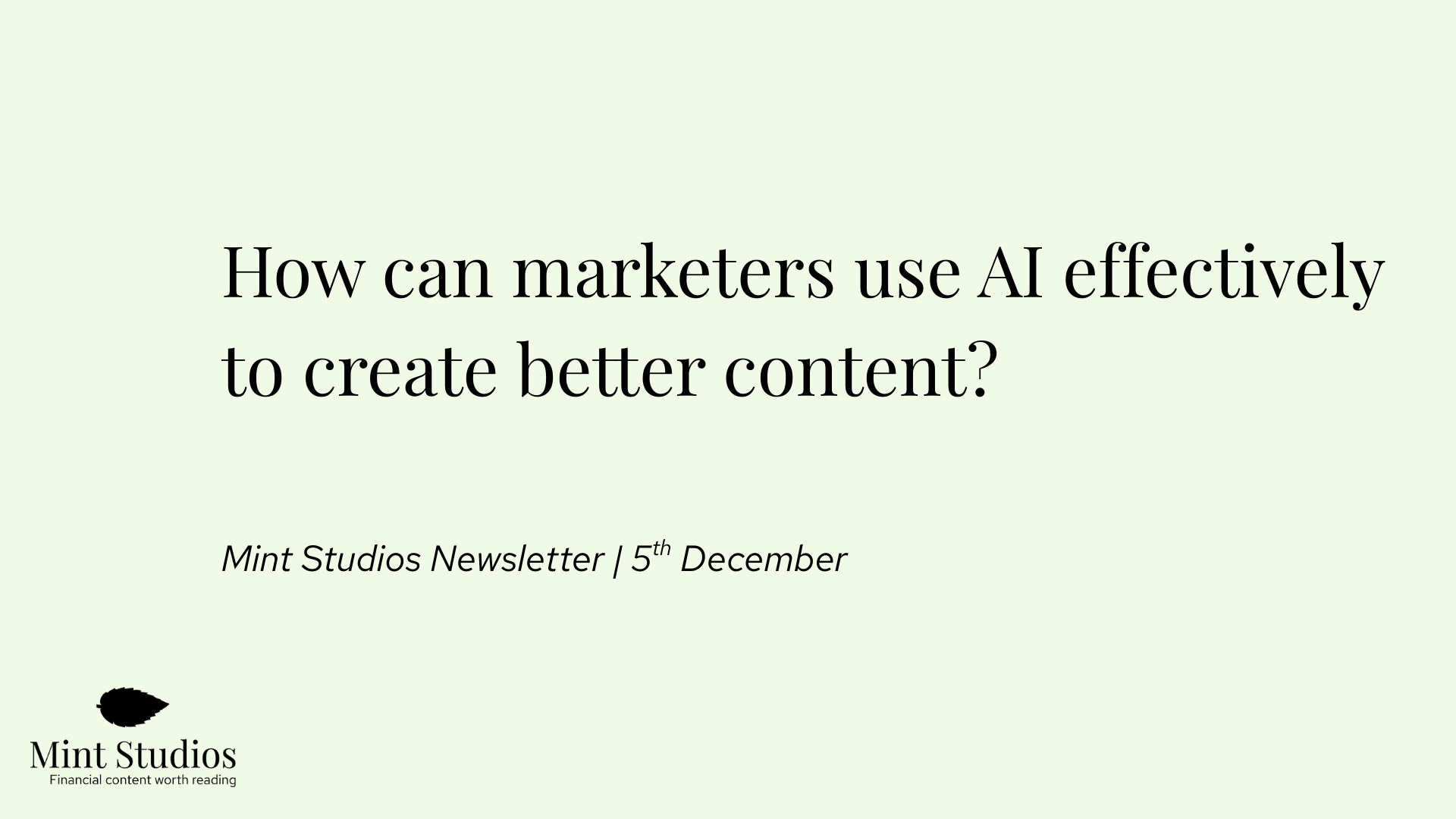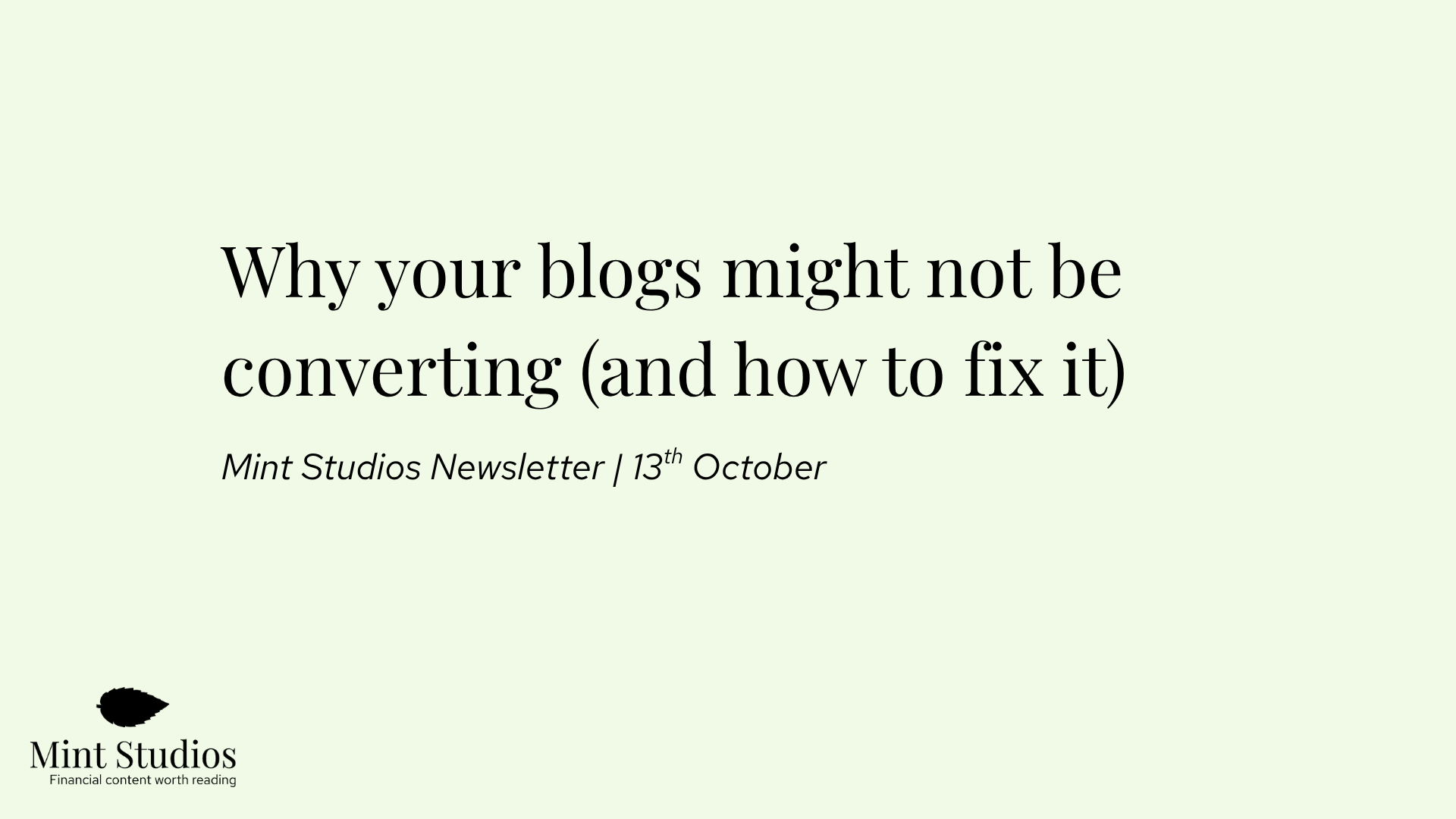One of the key challenges with implementing a content marketing and SEO programme is how long it can take to see results.
With ads and other forms of marketing, you can quickly find out if it’s working or not and tweak accordingly. But that’s not the case with content marketing. If things are not working, you won’t find out till later. And if things are working, it’ll often take months.
If only it were as easy as “we’ll invest in it once we see the returns”! But as any seasoned marketer and strategist knows, if that were the case then everyone would do it.
The amazing thing with content marketing, is that because it takes longer to see results, only those who are patient and understand how it works are those that get to experience the incredible results content can bring.
So how long could it take to see results? One year? Three months?
In this article we want to attempt to answer the question: “how long does it take for content marketing to work?”.
We’ll do this with real case studies of work we’ve done with our clients.
Note: we’re a content marketing agency that specialises in helping fintech companies acquire customers with content. Learn more about what we do.
What do we mean by “results”?
Before we dive into how long it takes, it’s important to define what we mean by “results”.
In the content and marketing world, the most common metric to track success with is traffic. In other words, how many pageviews is your content getting via organic search or specific type of referral traffic. If you’re getting more traffic every month, then congratulations: your content is succeeding.
Although traffic is an important metric, it doesn’t give you the whole picture. That’s because an increase in traffic does not equal an increase in conversions. In other words, high traffic does not always equal more sales.
That’s why it’s important to be aligned on results before tracking them. At Mint Studios, we aim to track the closest thing to cash in the bank. This could be form submissions. New deals created in Hubspot. Clicks that signify buying intent.
Essentially, we’re tracking sales-related metrics.
This is where a lot of marketers push back: tracking conversions accurately is hard. A new lead might be influenced by multiple touchpoints, not just content. And that lead that came via PPC? It’s possible they initially discovered you via Google.
And they’re right. However, we believe that that doesn’t mean you shouldn’t track sales-related metrics.
There are a lot of benefits to setting up content attribution to sales as a marketer:
- You can prove your efforts in business terms (leadership teams love that).
- You get credit for bringing in sales (so it’s not just all the sales team).
- It’ll help direct your marketing strategy if you ever need to focus more on new business.
Throughout the rest of the article, we’ll be focusing on answering the question: how long does it take for content marketing to bring in sales-related results? In other words, leads or sales.
This could be:
- New contacts created on Hubspot that came through a blog post.
- First and last click attributed conversions via Google Analytics.
- Closed deals via Hubspot/Pipedrive.
- Form submissions on Google Analytics.
- Clicks to app downloads.
Down below, we’re going to go through 4 different clients our and look at how long it took for each one to start seeing results. We’ll explain how we define success in each one.
Jeeves: started seeing leads from the first month
Jeeves is a B2B payment solution for startups and companies. They operate in a very competitive landscape (business credit cards), so we knew we had to be strategic with our content.
How did we define success?
With Jeeves, we measured:
- First engaged lead
- Qualified lead
- Organic traffic
- Rankings
Qualified leads only became leads if they completed a multi step form – meaning the company would have to have a certain amount of revenue, and therefore would be a lot more likely to become a customer.
With Jeeves, we started publishing in March of 2022, and in April, we already started seeing quite a few qualified leads coming in. Lead grew month over month until August, where due to product launches and new qualifying criteria, things changed. Things picked up again in January of 2023.
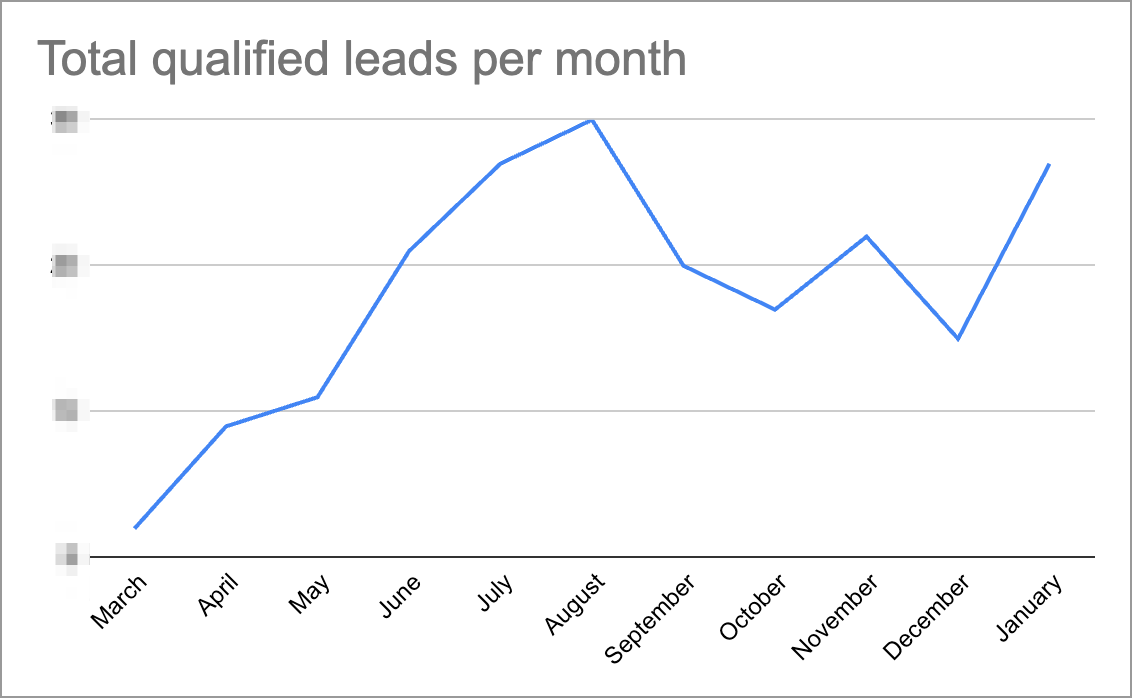
As we can see here, we started seeing results in the first month. Things really started taking off in May of 2022, so three months later.
What was our strategy? Right from the beginning, our strategy was to use our customer research methodology to understand who is Jeeves' best customer, what are their pain points and what would they be searching for online. Based on that research, we picked topics and keywords targeting people who were closer to converting – in other words, who were at the bottom of the buying funnel.
Learn more: What is BOFU (Bottom of the Funnel) Content and Why Is it Important?
Here are some of the articles we published:
- Travel Expense Management: How To Get It Right With Jeeves
- Best Business Credit Cards for Employees (We Compare 6!) [2023]
- Amex Business Card No Annual Fee: What's an Alternative?
Read more about our work with Jeeves here: Jeeves Case Study: Creating Content That Raises Awareness and Brings in Leads
Zai: leads from month two, takes off after nine months
Zai is a B2B payment orchestration company, and is the sister company to B2C payments company CurrencyFair. With Zai, we started publishing in April of 2022.
How did we define success?
With Zai we’re using Hubspot, so we track multiple conversions to track success:
- New contacts generated from blog posts (confirmed by the sales team via Salesforce)
- Influenced contacts generated from blog posts
- Deals created generated from blog posts (confirmed by sales team)
- Organic traffic
- Rankings
As you can see from the graph, we had a few new contacts created starting from June, two months after publishing.

But things only really took off in February of the year after – nine months later. Now, we’re consistently bringing a high number of new and influenced contacts, with multiple deals. In fact, we’re now bringing in enough leads and deals that we pay for ourselves (and a lot more).
It has taken quite a few months – but the revenue the content now generates far outweighs all the cost of all the months added on. You can see here the size of the deals that we’re bringing in:

Unlike paid ads, there is no ceiling with content. We’re going to continue to generate a high number of leads and deals as long as we keep publishing the right type of content. As you can see in this case, it took two months to see results, and around nine months for things to take off. Wouldn’t you agree that it’s well worth the wait?
What was our strategy? Like Jeeves, we focused on understanding who Zai’s best customer was and what they would be searching for online. We then focused on creating advanced content based on interviews with Zai internal experts. Here are some of the pieces we published:
- Direct Debit API: How to set one up (and when to use one)
- 3DS2: Everything you need to know and how to prepare for it
- Multi-party payments: How they work and when to implement them
Read our case study with Zai: Case Study: How We Helped Zai Gain Multiple SQLs Per Month with Content
Parpera: conversions from month six
Parpera is an app for freelancers and small businesses to manage their finances. We started publishing in December of 2021, and we started seeing conversions in April.
How did we define success?
In this case, success was tracking app downloads. This is hard to track accurately, so we tracked it in two ways:
- Using Google Tag Manager, certain clicks on the blog that indicate someone is going to download
- UTM links on the unique buttons on the blog post
We also tracked:
- Organic traffic
- Rankings
By April of 2022, we started to see an uptick and a healthy number of clicks coming in. In June, we had to unfortunately put pause on our work together because their banking partner Volt shut down so it didn’t make sense to continue. However, you can clearly see in this graph that it took around six months for conversions to trickle in and for content to take off.
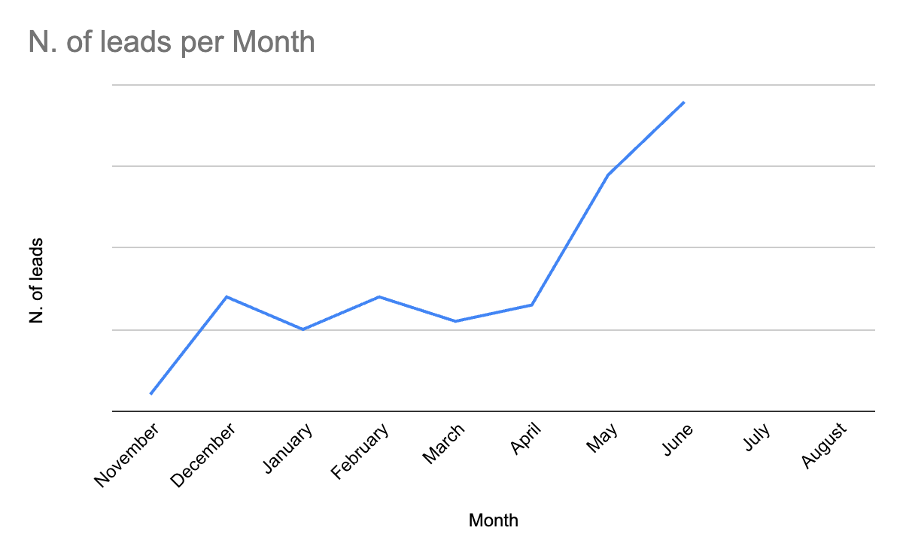
The website was almost brand new (Domain Authority of 18), which is why we didn’t see immediate conversions. But once again, the uptick finally came at around the six month mark. It reached a point where the conversions from the blog were generating conversions at a more cost effective rate than ads!
Here are some of the pieces we published:
- Wave Alternative In Australia: Parpera
- Apply for a Sole Trader ABN Online (In Under 10 Minutes)
- Freelancer Debit Card: Get One Online Quickly and Easily
Interestingly, although we haven’t been publishing for quite a few months, in May of 2023 Parpera is still getting a high amount of traffic and conversions.
Read more about our case study: How Parpera Used Content to Help Advance Their Mission of Financial Education and Acquire Customer Leads More Cost Effectively than with Ads
B2C app targeting creators: conversions from month six
This app targets creators and helps them earn an income with affiliate marketing. In this case, the website is brand new, so we knew it was going to take a while. But we still used our customer research methodology and began by targeting high-intent keywords.
How we defined success
- Clicks to sign up form: we used Google Tag Manager to track clicks to sign up to the form
- Organic traffic
- Rankings
We started publishing in July, and traffic and conversions were quite low. Things started to take off in December 2022 / January 2023, so again – around six months. In the last couple of months, conversions have been growing steadily, doubling in the last month.
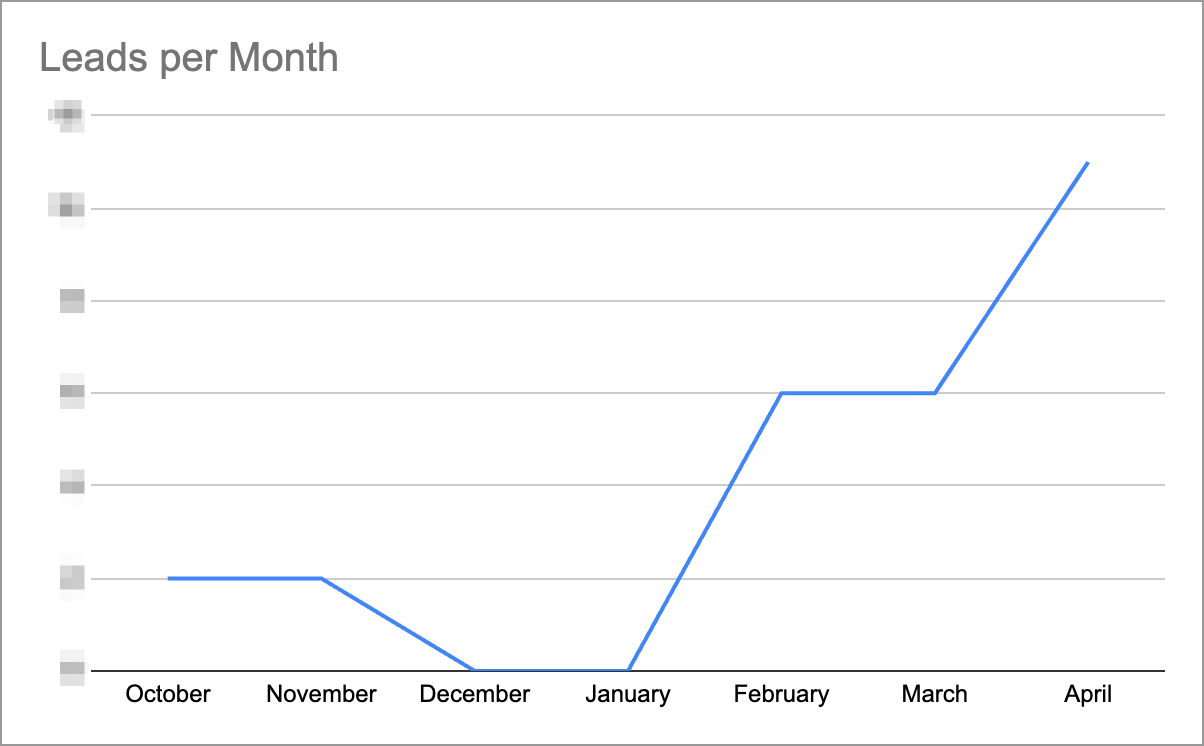
Even though we were publishing in a very niche market with a brand new website, we still managed to see results come in from around the six month mark.
What do content marketing results depend on?
As you can see, the answer to the question “how long does content marketing take” depends on a few things. With strong websites, you’ll see leads coming in immediately or from month 2 or 3. With smaller websites, we’ve usually seen good results at the six month mark. In general, six months is a safe estimation.
Ultimately, what does it depend on?
How old your website is
If you have a domain authority of under 25 it could take about a year to see results – especially if you’re in a competitive environment. If you’re in a competitive industry and have a young website, budget for about a year.
Your content strategy and who you’re targeting
In all those cases above, if we had targeted keywords with high volume we would have perhaps gotten traffic a lot earlier on. But that’s not our goal: we care about leads, conversions – not traffic. With Zai, traffic was incredibly low for the first 6 months, but that was fine because we were bringing in leads. We were focusing on the most important metrics from day one.
The only way we’re able to target the right keywords, is because when we first start working with someone, we spend the first month with the client understanding their best customers, the pain points and how they do research online. Beware of content agencies that can promise going right into creating content: it’s important to spend the time doing strategy and understanding who your customer is.
Based on that initial research, it’s then a lot easier to come up with content ideas that you know your target market will read. Specifically, we pick keywords and topics that indicate someone is close to buying (Bottom of the Funnel). We argue it makes more sense to start with those, and then work your way up the funnel (which is the opposite of what other marketers do).
If you decide to optimise for traffic rather than conversions, it’ll take a lot longer to get sales-related results from your content.
Learn more: How to Do Research for Bottom of the Funnel Content Marketing
Your actual written content
Ranking for the right keywords and targeting the right people is just half the battle – in order to get real sales, you need to write something that’s compelling to the reader. If you’re targeting a Head of Payments and start off the article with “What is a payment”, then you’ll lose them.
That’s why we focus on writing for your ideal customer (not just anyone who would be interested in the topic), and 90% of our content is based on an interview with an internal expert. If you read the articles above for Zai, you’ll see these are written for a very specific audience in mind.
If you’re writing for the wrong audience, then it’ll take a lot longer to see results (or any) from content marketing.
Learn more: Why You Should Create Content Based on Interviews With Experts
How often you publish (and how fast you review)
We like to do 2 - 4 articles per month. These are based on interviews with experts, are in-depth and we have an intense collaborative process to creating these pieces.
Whether you’re working with an agency, a freelancer, or someone in-house, you’re likely to have a review process. Ideally, you have a reasonably fast review process – if not, it can take a while to get things published.
Since we spend the first month working on the content strategy, we only start creating content in month two. Which means we often don’t get the first piece of content published until the end of the second month/beginning of the third month. So in this case, you then need to factor in six additional months to see results (so 9 months in total). This can take even longer if you have a lengthy review process.
It’s very important to have a fast, efficient and effective review process, to make sure content is reviewed and therefore published on time. Without that, you end up in a situation where content gets published one month late, delaying the time to get results (and therefore, increasing the likelihood that the leadership team pulls the plug on content due to “lack of results”).
The attitude of “we’ll invest more once we see results” won’t work with content marketing. As you can see from the results of our clients above, it can often take over six months to see results from content. But as you can see, almost all of them are exponential: once you do get results, the numbers take off. Often, the number of leads and new business we generate for our customers pays for all those six months and a lot more. You wouldn’t get that with ads.
The patience that’s required to see content marketing succeed, means not everyone invests in it. Which is why we’re confident content marketing will always remain an opportunity for those willing to invest in the long term.


